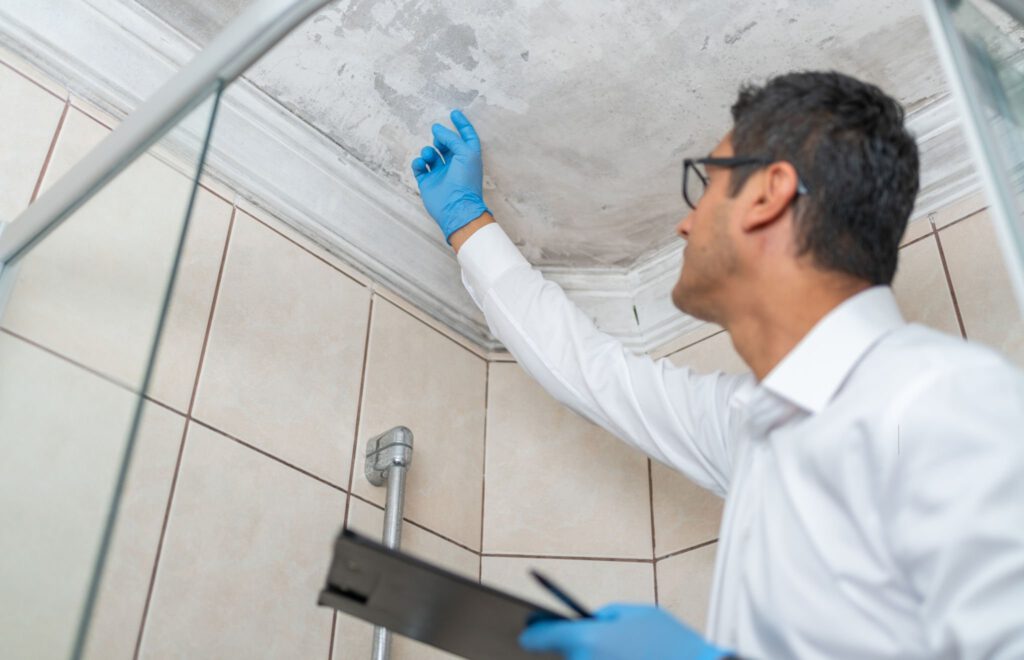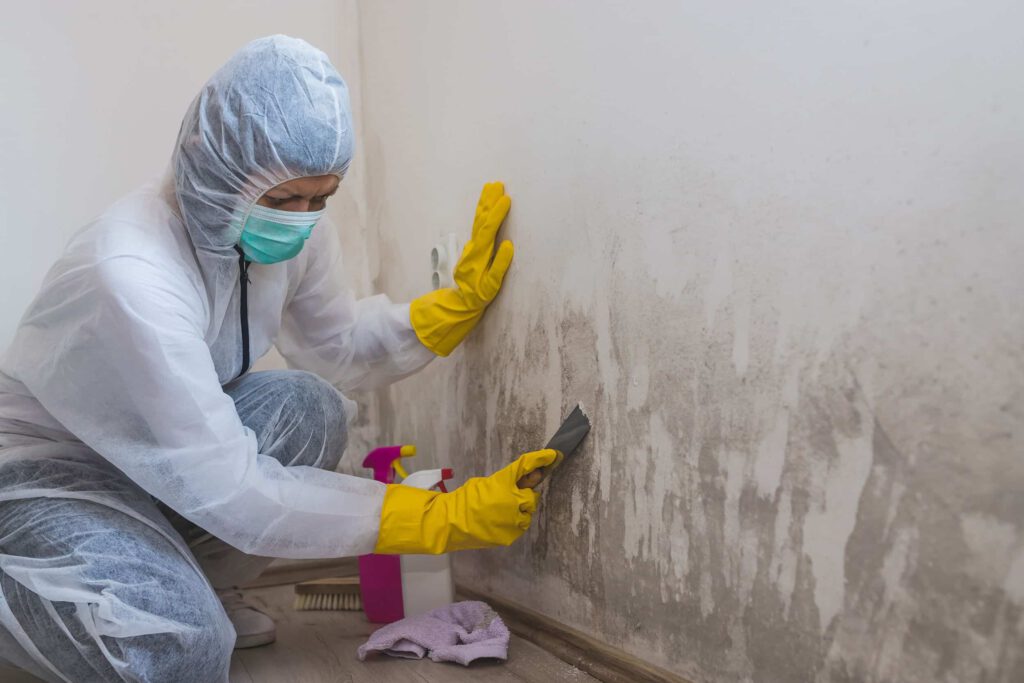Mold growth can be a homeowner’s worst nightmare. It can leave ugly stains and nasty smells and even harm your and your family’s health. That’s why it’s crucial to take proactive measures to prevent mold growth in your home. Moisture is a significant cause of mold growth. By understanding the role of moisture in mold growth and implementing effective moisture detection methods, you can safeguard your home from this persistent problem.
Exploring How Moisture Affects Mold Growth
Before delving into moisture detection methods, it’s essential to understand how moisture contributes to mold growth. Mold thrives in damp and humid environments, where it can feed on organic materials like wood, drywall, and fabric. Moisture acts as a catalyst for mold spores to germinate and multiply rapidly. Even a small water leak or high humidity levels can create an ideal breeding ground for mold. That’s why it’s crucial to promptly identify and address moisture issues to prevent mold from taking hold in your home.
Signs of Moisture Problems in the Home
Visible Water Stains or Discoloration
Water stains on walls, ceilings, or floors indicate moisture issues within your home. Leaks, condensation buildup, or inadequate ventilation typically cause these stains. Look for discoloration or unusual spots, especially in damp areas like bathrooms, kitchens, and basements.
Musty Odors
A musty or earthy smell lingering in your home could signify the presence of mold. This distinct odor often accompanies moisture problems and should not be ignored. If you detect a persistent musty smell, it’s crucial to investigate the source promptly. Addressing any underlying moisture issues is essential to prevent mold growth and maintain indoor air quality.
Mold Growth
Visible mold growth is a clear indication of moisture problems within the home. Mold can manifest as black spots, fuzzy patches, or discolored areas on walls, ceilings, or furniture. Prompt action is necessary upon discovering mold to prevent further proliferation and potential health risks associated with exposure. Regular inspections and proactive measures can help mitigate moisture-related issues and safeguard your home environment.
DIY Methods for Detecting Moisture in Your Home
Visual Inspection
Begin by conducting a thorough visual inspection of your home. Focus on moisture-prone areas like bathrooms, kitchens, basements, and crawl spaces. Look closely for any signs of water damage, condensation buildup, or mold. These visual cues can often indicate underlying moisture issues that need attention.
Using a Moisture Meter
Utilizing a moisture meter is a practical approach to measuring the moisture content in various materials throughout your home. These meters can assess moisture levels in walls, floors, and furniture, helping you pinpoint areas of elevated moisture that could signify potential problems. By employing a moisture meter, you can efficiently identify areas requiring further investigation or remediation.
Duct Tape Test
The duct tape test offers a straightforward yet reliable method for detecting moisture on walls. To perform this test, firmly apply a piece of duct tape to the suspected area of the wall and leave it in place for 24 hours. After the designated period, carefully remove the tape. Any moisture on the tape upon removal indicates a moisture issue within the wall. This simple test can provide valuable insights into potential moisture problems requiring professional attention.
Essential Tools for Moisture Detection
Moisture meter
As mentioned earlier, a moisture meter is a valuable tool for measuring moisture levels in various materials. Look for a moisture meter that is easy to use and provides accurate readings.
Infrared camera
An infrared camera, also known as a thermal imaging camera, can detect temperature variations that may indicate moisture issues. This tool is handy for identifying hidden leaks or areas with poor insulation.
Hygrometer
A hygrometer measures humidity levels in the air. Monitoring indoor humidity is crucial for preventing mold growth. To create an inhospitable environment for mold, keep humidity levels between 30% and 50%.
Steps for Preventing Mold Growth Through Moisture Control
Fix Leaks Promptly
Address any sources of water intrusion promptly to prevent moisture buildup and reduce the risk of mold growth. Swift action is essential in mitigating potential moisture-related issues, whether a dripping faucet, a leaking pipe, or a faulty roof.
Improve Ventilation
Proper ventilation is crucial in moisture-prone areas, such as bathrooms, kitchens, and laundry rooms. Install exhaust fans or keep windows open to escape moist air. This helps lower humidity levels and minimize condensation, reducing the likelihood of mold formation.
Ensure Proper Insulation
Insufficient insulation can contribute to condensation and moisture problems within your home. Ensure your property is insulated to prevent moist air from contacting cold surfaces. Proper insulation helps maintain consistent temperature levels, reducing the risk of moisture accumulation and subsequent mold growth.
Common Areas in the Home Prone to Moisture Problems
Bathrooms
Bathrooms are notorious for moisture-related issues due to the frequent use of water. To prevent problems, ensure proper ventilation by using exhaust fans or opening windows. Regularly inspect for leaks in pipes, faucets, and around fixtures, and promptly address any plumbing issues to prevent moisture buildup and mold growth.
Kitchens
The kitchen is another area prone to moisture problems, particularly during cooking and dishwashing. To mitigate moisture issues, utilize exhaust fans while cooking to remove steam and moisture from the air. Wipe down countertops and surfaces to eliminate excess moisture, and check for leaks under sinks and appliances regularly to prevent water damage and mold growth.
Basements and Crawl Spaces
Basements and crawl spaces are susceptible to high humidity levels and water intrusion, making them prime environments for mold growth. To combat moisture problems, consider installing dehumidifiers to regulate humidity levels. Seal any cracks or gaps in walls, floors, or foundations to prevent moisture from entering.
Additionally, explore waterproofing options such as sealing walls or installing drainage systems to keep moisture out and safeguard against mold growth. Regular maintenance and proactive measures are crucial in preventing moisture-related issues in these areas of the home.

Tips for Maintaining Proper Ventilation and Air Circulation
Open Windows and Doors
The simplest way to promote air circulation is by opening windows and doors when the weather is favorable. This action allows for exchanging indoor air with outdoor air, effectively diluting and removing humid air from your living spaces.
Install and Utilize Exhaust Fans
Essential areas such as bathrooms, kitchens, and laundry rooms are prone to high humidity. Installing exhaust fans in these locations helps actively remove moisture and unpleasant odors. It’s crucial to ensure that these fans vent directly outside to prevent moisture from being redirected to areas like the attic or crawl spaces, which can contribute to mold growth.
Clean Air Ducts and Filters
The heart of your home’s ventilation system—the HVAC system—requires regular maintenance to function efficiently. This includes cleaning air ducts and replacing filters as recommended by the manufacturer. Proper maintenance not only facilitates better air circulation and moisture control but also enhances the overall air quality in your home.
Effective Strategies for Managing Indoor Humidity Levels
Utilize Dehumidifiers
Dehumidifiers can effectively remove excess moisture from the air in areas prone to high humidity, like basements and bathrooms. Regularly emptying and cleaning the dehumidifier is crucial to prevent mold growth and ensure optimal air quality.
Address Plumbing Issues
Leaky pipes or faucets are common culprits behind elevated indoor humidity levels. Promptly fixing such plumbing issues is essential to prevent moisture buildup and maintain a comfortable indoor environment.
Monitor Indoor Plants
While indoor plants contribute to better air quality, they can also elevate humidity levels if not properly managed. To mitigate this, place plants in well-ventilated areas and avoid overwatering them. By striking a balance, you can enjoy the benefits of indoor greenery without compromising humidity control.
Professional Moisture Detection Services and when to Consider Hiring them
Persistent Mold Growth
If you constantly battle mold growth despite your efforts to eradicate it, it might be time to seek professional assistance. Professionals equipped with specialized tools can pinpoint hidden moisture sources fueling mold growth. Identifying and addressing these sources effectively can help prevent mold from returning.
Extensive Water Damage
In situations with extensive water damage, such as floods or burst pipes, relying on professional moisture detection services is crucial. These experts can accurately assess the extent of the damage and recommend appropriate remediation measures. Prompt and thorough action is essential to prevent further structural damage and mold growth.
Real Estate Transactions
Investing in a professional moisture inspection is a wise decision whether you buy or sell a property. This inspection can uncover any underlying moisture issues affecting the property’s value or safety. Addressing these issues proactively avoids potential headaches and ensures a smoother transaction process.
Conclusion
Preventing mold growth in your home is essential for maintaining a healthy and safe living environment. You can keep mold at bay by understanding the role of moisture in mold growth, employing effective moisture detection methods, and implementing preventive measures. Remember to regularly inspect for signs of moisture problems, maintain proper ventilation and air circulation, and promptly address any leaks or plumbing issues. By taking a proactive approach, you can protect your home and your loved ones from the harmful effects of mold.
When it comes to mold testing, you need a reliable and trustworthy service provider. Mold Testing Houston offers fast, affordable, and dependable mold testing services. Take your time with your health and the integrity of your home. Contact Mold Testing Houston today for a comprehensive and professional mold inspection. Visit our website at Mold Testing Houston to learn more and schedule an appointment.
Frequently Asked Questions
How can I schedule a mold inspection?
To schedule a mold inspection with Mold Testing Houston, visit our website and fill out the contact form. A representative will contact you to discuss your needs and schedule an appointment that works for you.
How long does a mold inspection take?
The duration of a mold inspection depends on various factors, such as the size of the property and the extent of the inspection required. On average, a mold inspection can take one to three hours. For more extensive or more intricate properties, extra time might be needed.
How soon can I get the results of the mold test?
Mold Testing Houston understands the urgency of obtaining mold test results. We strive to provide fast turnaround times and deliver results within 24 to 48 hours after the inspection. However, the exact timeframe may vary depending on the nature of the samples collected and the testing method used.
Are the mold testing services offered by Mold Testing Houston affordable?
Mold Testing Houston is committed to providing affordable mold testing services Houston TX without compromising quality. We offer competitive pricing and transparent upfront costs. Contact us today to get a quote tailored to your specific needs.
How can I contact Mold Testing Houston for more information?
For more information about Mold Testing Houston’s mold testing services, visit our website. Alternatively, you can contact them at (832) 409-2125 or by email at moldtestinghouston@gmail.com. Our experienced team is here to help you with any inquiries or worries.
Prevent mold growth with DIY moisture detection! Essential tips for homeowners to safeguard their homes against moisture-related issues.






